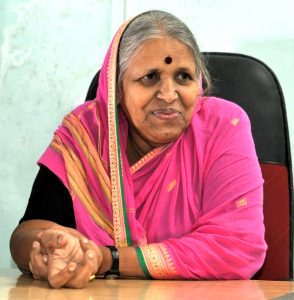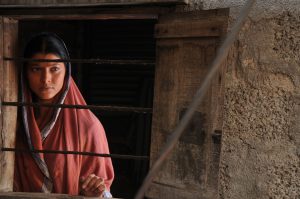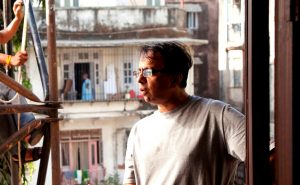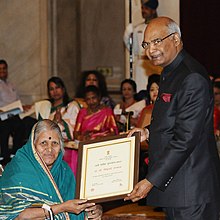The best takeaway from a biopic, even fictional, is that we learn about unsung heroes whose contribution to their field of would have perhaps remained unknown unless these films were made. Paan Singh Tomar, Soorma, Gunjan Saxena – The Kargil Girl are just a few examples. Mee Sindhutai Sapkal directed by Ananth Mahadevan sheds light on the real-life fighter of a woman, Sindhutai Sapkal. But the film was made in 2010. Then, why is it suddenly in the news now? It is because Sindhutai Sapkal has been bestowed the Padma Shri for her social work in 2021.

But this is just one of the many awards she has collected along the way, rising from a very dark past filled with torture, abandonment, abuse and finally reduced to begging in temple precincts in the villages and small towns of Maharasthra. She was also gifted with a Doctorate in Literature by the DY Patil Institute of Technology and Research in 2016 and the Nari Shakti Puraskar in 2017. She is now a ripe but very active 72 years old. She is better known among her ‘orphans’ as Mai or Mother.

The film is based on Sindhutai’s autobiography Mee Vanvasi. journalist-actor-director-author-theatre person Ananth Mahadevan is known for directing biopics of people who work outside the glare of mainstream media. Mi Sindhutai Sapkal is one such film
He structures the film using a flight to San Francisco as the anchor that holds the flashbacks together. Sindhutai meets a middle-aged man (Ananth Mahadevan) seated beside her on the flight who is going to San Francisco to meet his daughter. Sindhutai has been invited to deliver a speech by Maharashtra Sahitya Mandal in the US. This is her first flight and her first trip abroad. The story of her life spins out between the interactions of these two people distanced in terms of age, education, language and culture but are able to find common ground in a brief friendship. This is an unusual structure and tends to confuse at times but works out in the end.

The camera and editing keep jumping from the present to the past beginning with the little Chhindi, a very derogatory nickname she was given as a child. Her father is intent on educating the girl but the mother does not want it at all as she feels the girl will get married anyway. So, she is forced to quit studies after class IV and can never get over this hunger for education.
The most outstanding quality about the film is Mahadevan’s ability to match the looks of the ageing Sindhutai with the real Sindhutai even from the time she was a little girl.
The little Chhindi loves to go to school and study but burdened by the pressure of her mother on the one hand and their dire poverty on the other, the father is forced to marry off the little Chhindi, then 12, to a much older man. She is packed off to her in-law’s home to become a perennial victim of domestic abuse. The degree of abuse intensifies especially when the husband realises that she loves to read. She quietly takes in all the humiliation including being molested by her husband’s younger brother but everyone turns a blind eye and her younger sister-in-law tells her to take it in her stride.

Only once in her 14 years with him, her husband tells her that he is beside her whatever happens. But soon after, he throws her out wrongly accusing her of bearing a child that is not his. The instigation comes from a farm labour contractor who avenges Chhindi’s mobilising the village women to claim their right to be paid for work. Pregnant and half-fed, she is cast out to the cowshed and later thrown out with her infant girl. The husband keeps the two boys with him. When she seeks shelter from her mother, she turns her away even before she can reach her home, her father having passed away. There is a very touching scene where the father arrives at Chhindi’s place asking her to treat him to puran poli. The following day he passes away.
Then begins the incredible true story of Sindhutai Sakpal. She threw away her name Chhindi and chose to christen herself Sindhutai but retains the husband’s family name which, many years later, she tells her husband she has borne like a burden as they were never divorced. Ironically, the same man, when he is doddering and old, comes to her for shelter. She accepts him but not as her husband but as one of the many ‘sons’ she already has.
She is packed off to her in-law’s home to become a perennial victim of domestic abuse. The degree of abuse intensifies especially when the husband realises that she loves to read.
Her journey of struggling to make both ends meet forces her to keep her daughter in the custody of a woman she befriends in one of her musical journeys through temples. Later, she admits that she kept her at a distance so that she would treat the orphans as her own and makes no distinction between her biological offspring and the ones she has taken under her shelter.

Her journey ends in the US with her speech in a house filled with a Maharashtrian audience who happily chip in to her appeal for donations to her orphanage fund. The most outstanding quality about the film is Mahadevan’s ability to match the looks of the ageing Sindhutai with the real Sindhutai even from the time she was a little girl. The resemblance, especially when she is old, is astounding to say the least.

Tejaswini Pandit as the young Sindhutai throws up a wonderful performance throughout. The desperation that pushes her to throw herself under the railway tracks is matched with the courage she gathers from herself to move on, come what may. The girl who plays little Chhindi is also competent. Jyoti Chandekar’s older and ageing Sindhutai is invested with the dignity the character demands, carrying on the dignity that gives her personality an extra edge. Upendra Limaye is very good as the husband in younger days and expresses his ruthlessness simply through his body language and his manner of speech. Till the end of his life, he refuses to acknowledge the daughter as his own.

Mahadevan and Sanjay Pawar’s screenplay is tight, terse and feels the pulse of the story aptly, keeping expectations of the audience rising with every journey Sindhutai makes, waiting for the final denouement.
The cinematography plays around with shades of yellows, browns and siennas as the camera wanders across the paddy fields, the different villages of Maharashtra following Sindhutai as she manages to keep body and soul together by singing devotional songs at temples. This brings across an overuse of music and songs bringing the film closer to the mainstream which, perhaps, could have been cut down a bit. One song is especially relevant in the scenario. The editor faces the challenge of cutting smoothly from the interiors of Chhindi’s old home to her husband’s home to the world outside, through temples to finally arrive at the orphanages she sets up one by one, becoming Mai to hundreds of orphans some of who do extremely well in life and get back to help her in her commitment to orphans.
Mee Sindhutai Sapkal is a multi-layered story teaches us that even a semi-literate, impoverished, oppressed and wronged single mother can rise above all obstacles, and become a fairy godmother for street children.
Shoma A. Chatterji is a freelance journalist, film scholar and author based in Kolkata. She has won the National Award twice, in 1991 and 2000. She has authored 26 published titles of which 14 are on different areas of Indian cinema. She holds two Masters Degrees and a Ph.D. in History (Indian Cinema). She has also won a few Lifetime Achievement Awards from different organizations over time.








